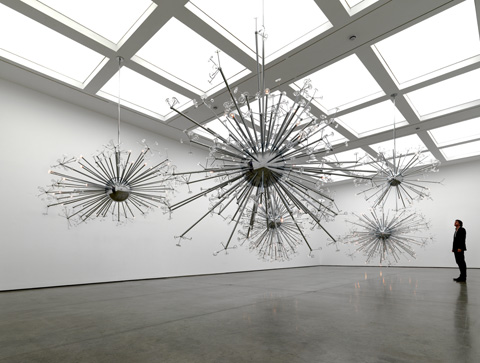
ISLAND UNIVERSE Rather than prompting big cosmic contemplations, McElheny's "Big Bang" pieces
inspire thoughts like: "wow, big shiny pretty." |
In 2000, when Josiah McElheny attended his first performance at New York's Metropolitan Opera House, he was wowed by the auditorium's 1966 midcentury modern "starburst" chandeliers. "They're kind of Gilded Age/space-age objects, and they immediately looked to me like a galaxy or an explosion — a Pop image of the big bang," he told Artforum in 2005.
>> SLIDESHOW: "Josiah McElheny: Some Pictures of the Infinite" <<
"What if I remade the chandelier," he asked himself, "so that instead of it being a gloss on the theory, all of the decisions were determined by the actual science of the origin of the universe?"
Island Universe (2008), a set of five of his Big Bang chandeliers — with cosmologist David Weinberg advising him on the science — hang throughout the final gallery of "Some Pictures of the Infinite," a two-decade survey of the Boston-born, New York-based glass artist's work at the Institute of Contemporary Art (100 Northern Ave, through October 14). Chromed spokes spear out of chrome balls like a Star Wars hyperdrive. They end in glass discs and balls that McElheny blew or cast (he jobs out the metalwork), some of which blink on and off. The sculptures are 10-foot-wide glass-and-chrome dandelions. They are wondrous, blingy, shiny happy things. The show is part of the ICA's long-running series of wondrous and/or blingy neo-Minimalism.
Curator Helen Molesworth flatters McElheny's work by selecting pieces that, for her, address "time: historical times, archeological time, revolutionary time, and, most recently, cosmic time." Featured are fragments of faux ancient Roman glass, a gold-dotted glass disc that replicates a halo in a Botticelli painting, mirrors, photos, and a film. They reveal that McElheny's real interest is post-modern trawling through history for designs that he can replicate. This aspect of his work suggests dry academic conceptualism.
But McElheny's hits begin with mirrored vitrines like Czech Modernism Mirrored and Reflected Infinitely (2005). We look through a one-way mirror at eight streamlined mirrored glass decanters inside a mirrored box. The single set seems to repeat forever, the lines curving off into darkness. McElheny intends a horrifying picture of mass production; the effect is of a dazzling jewelry shop window.
The chandeliers are his other hit. An actual star map dictates the design of Study for the Center Is Everywhere (2012), a gaudy Vegas hotel lamp with a round disc that dangles lights and crystals straight down on brass rods. The five Big Bang chandeliers of Island Universe derive from theoretical models of universe formation, which may all coexist under the multiverse theory. Or something. Conveying information isn't McElheny's strength. Rather than prompting big cosmic contemplations, these pieces inspire thoughts like: "Wow, big shiny pretty." Which is nothing to sneeze at.
But if we were to follow McElheny's line of thought, the Met chandeliers that inspired him lead me to a different Big Bang — the atomic bomb at the heart of America's post-World War II superpower status, and the opera house (or the ICA) as a monument to the attendant wealth and prestige. The designers of the Met chandeliers were thinking of space. McElheny proposes they had their minds on the just-published Big Bang theory. The subtext for me is President Kennedy's 1962 vision of putting an American on the moon. He wasn't just proclaiming America's cosmic determination and curiosity, he aimed to beat the Soviets to the moon, to build better rockets than them, and strap nukes onto those firecrackers. "We have vowed that we shall not see [space] governed by a hostile flag of conquest," he said, "but by a banner of freedom and peace."
Read Greg Cook's blog at gregcookland.com/journal.